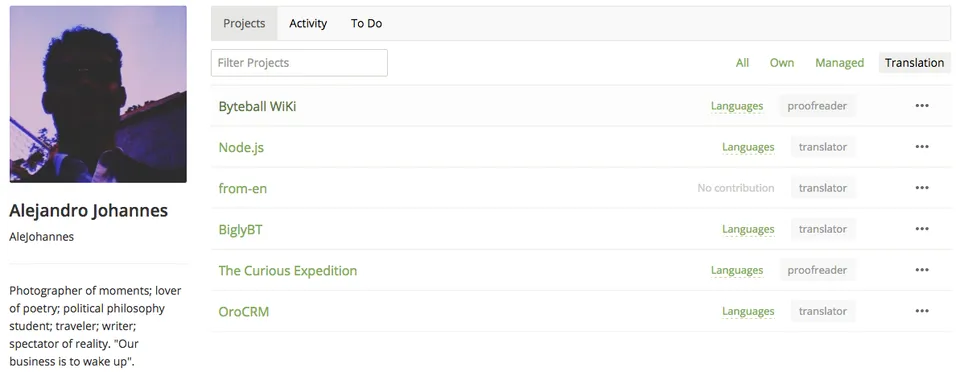Github Repository
https://github.com/nodejs/i18n
Project Details
By definition, Node.js is a Java Runtime Environment (JRE). But it is more than just that. While common JREs serve as machine backups that allow users to smoothly run JavaScript on their browsers and applications, this open-source project functions as an app that manages Java code by itself. It's practical uses for developers are endless. It grants an extraordinarily versatile platform for designing code, programs, websites and other applications. And that isn't all: Node provides a virtual facility for testing the proper work of Java-driven programs and devices –and their planned updates–, helping to find bugs, solve errors, fix code and vastly improving their performance.
I believe all the amazing uses of Node are to be considered by themselves and I declare myself a fan of the project. But, besides, I support it for its working properties as a medium for bringing to reality countless creations that can be as good as Node itself. Imagination (and Java) is the limit! The open translation of Node to thirty-three (33) languages proves the advantages of open-source projects when it comes to diversification of knowledge and worldwide spreading of useful tools.
Ahead, there is the link of the program's webpage:
Contribution Specifications
Translation Overview
This is my 19th contribution to Node.js as a translator. For this collaboration, I continued my previous work on CHANGELOG_V10.md file. This document contains an ordered list of the commit logs of all accepted pull-requests related to Node's Version 10.
As I explained in my past translation reports, a changelog is a registry of all the changes made on determined project for each one of its versions. The files created for such purpose list modifications on internal components, substitutions of protocols, updates, deprecations, addition of supported tools, new functions, corrected errors and fixed bugs. In summary: every feature that first appeared or was removed in the program version being addressed must be specified and described in this registry. This is made with the purpose of providing a timeline of the development of the project and, by doing so, helping programmers to check any details they need to understand the way it came to be what it is and improve it in the future.
I'll refer to one of the logs I translated to illustrate the dynamics of the changelog. This one belongs to the Semver-patch sub-section of the Commits, which is the part of the document I worked in this occasion.

There are two important elements involved in this log. Being able to understand it requires that we address each of them particularly.
The first one is "parameter". In computer science, a parameter is a variable value that conducts determined aspect of the execution of an specific sub-routine. Though it has certain similarity with regular arguments, it has a superior importance in functions. Parameters dictate the way functions behave and deal with the data that is passed to them, which is what arguments are... That's why they're called "formal arguments", they define the methods by which arguments will be managed.
As an example, let's say a function dictates a soccer game to be played and throws the results of such game as its output. While the players of the game might be the arguments, its conditions are the parameters. Then, through them, we would specify the duration of the game, the weather, which team is visiting and which one is home, and, ultimately, if the referee was bought to let one team win (BUUUUH!).... Then... Game on!
P.D.: It would actually be very logic that it is a parameter what keeps pushing Neymar to the ground... We would all live in a computerized simulation... But I can't find any other explanation that makes sense...

The other term we need to define is "assertion". An assertion is a predicate introduced amidst a program stating what the programmer know shall be the correct behavior of it at certain point of its execution. This way, when something goes differently from what was planned, the developers can be alerted and polish the coding of the program so it does what it was designed to do the way it was designed to do it. To understand it better: an assertion is that one Star Wars character of every movie that sees the unexpected way things are going and says "I got a bad feeling about this".... And is always right...

Having clarified all that, we can address the quoted entry. For any unforeseen reason, the function [internalAssert], used to set asserts amidst Node's code, was lacking of one parameter: the one that configured the delivery of messages to the user. What this commit resumes is the modification of the program's components so the passing of that parameter is always guaranteed and users get from the program information that is suitable for their objectives.
You can check some references here for more information about the previously addressed concepts:
- https://stackoverflow.com/questions/12709026/difference-between-arguments-and-parameters-in-java
- https://www.techopedia.com/definition/3725/parameter-param
- https://en.wikipedia.org/wiki/Parameter_(computer_programming)
- https://docs.oracle.com/javase/7/docs/technotes/guides/language/assert.html
- https://www.geeksforgeeks.org/assertions-in-java/
- https://en.wikipedia.org/wiki/Assertion_(software_development)
All changes included in each one of the versions of the project are formatted as pull-request commits. Id est, they are presented as very brief comments about the action that was suggested, are normally written with imperative verbs, and have a strict limitation on their number of characters (so even complex ideas are reduced to a small amount of words). These specifications made the translation of this document a challenge. However, it was satisfactorily achieved. As you will see in the examples below, the name of the developer who provided each log is often referred inside parenthesis at the end of it.
Work example #01:
English:
[<0>3567ea034e</0>] - <1>doc</1>: fix added value for <2>assert</2> module (Ruben Bridgewater) <3>#19724</3>
Spanish:
[<0>3567ea034e</0>] - <1>doc</1>: corregir valor añadido para el módulo <2>assert</2> (Ruben Bridgewater) <3>#19724</3>
Work example #02:
English:
[<0>0eec0735d0</0>] - <1>doc</1>: update internal errors documentation (Michaël Zasso) <2>#19203</2>
Spanish:
[<0>0eec0735d0</0>] - <1>doc</1>: actualizar la documentación de los errores internos (Michaël Zasso) <2>#19203</2>
Work example #03:
English:
[<0>cf46ca76ff</0>] - <1>domain</1>: converted anonymous to named function (Daven Casia) <2>#20021</2>
Spanish:
[<0>cf46ca76ff</0>] - <1>domain</1>: se convirtió una función anónima en una con nombre (Daven Casia) <2>#20021</2>
Languages
This translation was made from English to Spanish.
I got plenty experience translating and proofreading this project as an Utopian contributor. I collaborate here as translator and Language Moderator of the Da-Vinci/Utopian Spanish translation team. Besides this project, I have experience translating and proofreading The Curious Expedition, Ancap-ch, Byteball Wiki, OroCrm and BiglyBT.
Word Count
- The amount of words translated in this contribution is: 1372.
- The total amount of words translated in this project (as a Da-vinci/Utopian translator) is: 20346.
Previous Translations of the Project
- Contribution N'01. Submitted on September 13th, 2018.
- Contribution N'02. Submitted on September 15th, 2018.
- Contribution N'03. Submitted on September 17th, 2018.
- Contribution N'04. Submitted on September 19th, 2018.
- Contribution N'05. Submitted on September 21th, 2018.
- Contribution N'06. Submitted on September 22th, 2018.
- Contribution N'07. Submitted on September 23th, 2018.
- Contribution N'08. Submitted on October 1st, 2018.
- Contribution N'09. Submitted on October 8th, 2018.
- Contribution N'10. Submitted on October 14th, 2018.
- Contribution N'11. Submitted on October 15th, 2018.
- Contribution N'12. Submitted on October 18th, 2018.
- Contribution N'13. Submitted on October 21st, 2018.
- Contribution N'14. Submitted on October 24th, 2018.
- Contribution N'15. Submitted on October 27th, 2018.
- Contribution N'16. Submitted on October 31th, 2018.
- Contribution N'17. Submitted on November 3rd, 2018.
- Contribution N'18. Submitted on November 4th, 2018.
Proof of Authorship
This translation was made on November 5th, 2018. You can check the translation record in my Crowdin account [here], the activity on the project's Crowdin [here] and a summary of recent additions to the project [here].


